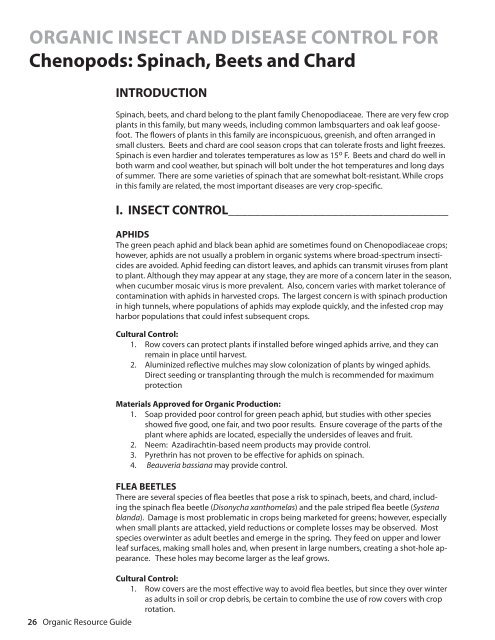Resource Guide for Organic Insect and Disease ... - Cornell University
Resource Guide for Organic Insect and Disease ... - Cornell University
Resource Guide for Organic Insect and Disease ... - Cornell University
You also want an ePaper? Increase the reach of your titles
YUMPU automatically turns print PDFs into web optimized ePapers that Google loves.
ORGANIC INSECT AND DISEASE CONTROL FOR<br />
Chenopods: Spinach, Beets <strong>and</strong> Chard<br />
26 <strong>Organic</strong> <strong>Resource</strong> <strong>Guide</strong><br />
INTRODUCTION<br />
Spinach, beets, <strong>and</strong> chard belong to the plant family Chenopodiaceae. There are very few crop<br />
plants in this family, but many weeds, including common lambsquarters <strong>and</strong> oak leaf goosefoot.<br />
The flowers of plants in this family are inconspicuous, greenish, <strong>and</strong> often arranged in<br />
small clusters. Beets <strong>and</strong> chard are cool season crops that can tolerate frosts <strong>and</strong> light freezes.<br />
Spinach is even hardier <strong>and</strong> tolerates temperatures as low as 15 o F. Beets <strong>and</strong> chard do well in<br />
both warm <strong>and</strong> cool weather, but spinach will bolt under the hot temperatures <strong>and</strong> long days<br />
of summer. There are some varieties of spinach that are somewhat bolt-resistant. While crops<br />
in this family are related, the most important diseases are very crop-specific.<br />
I. INSECT CONTROL__________________________________<br />
APHIDS<br />
The green peach aphid <strong>and</strong> black bean aphid are sometimes found on Chenopodiaceae crops;<br />
however, aphids are not usually a problem in organic systems where broad-spectrum insecticides<br />
are avoided. Aphid feeding can distort leaves, <strong>and</strong> aphids can transmit viruses from plant<br />
to plant. Although they may appear at any stage, they are more of a concern later in the season,<br />
when cucumber mosaic virus is more prevalent. Also, concern varies with market tolerance of<br />
contamination with aphids in harvested crops. The largest concern is with spinach production<br />
in high tunnels, where populations of aphids may explode quickly, <strong>and</strong> the infested crop may<br />
harbor populations that could infest subsequent crops.<br />
Cultural Control:<br />
1. Row covers can protect plants if installed be<strong>for</strong>e winged aphids arrive, <strong>and</strong> they can<br />
remain in place until harvest.<br />
2. Aluminized reflective mulches may slow colonization of plants by winged aphids.<br />
Direct seeding or transplanting through the mulch is recommended <strong>for</strong> maximum<br />
protection<br />
Materials Approved <strong>for</strong> <strong>Organic</strong> Production:<br />
1. Soap provided poor control <strong>for</strong> green peach aphid, but studies with other species<br />
showed five good, one fair, <strong>and</strong> two poor results. Ensure coverage of the parts of the<br />
plant where aphids are located, especially the undersides of leaves <strong>and</strong> fruit.<br />
2. Neem: Azadirachtin-based neem products may provide control.<br />
3. Pyrethrin has not proven to be effective <strong>for</strong> aphids on spinach.<br />
4. Beauveria bassiana may provide control.<br />
FLEA BEETLES<br />
There are several species of flea beetles that pose a risk to spinach, beets, <strong>and</strong> chard, including<br />
the spinach flea beetle (Disonycha xanthomelas) <strong>and</strong> the pale striped flea beetle (Systena<br />
bl<strong>and</strong>a). Damage is most problematic in crops being marketed <strong>for</strong> greens; however, especially<br />
when small plants are attacked, yield reductions or complete losses may be observed. Most<br />
species overwinter as adult beetles <strong>and</strong> emerge in the spring. They feed on upper <strong>and</strong> lower<br />
leaf surfaces, making small holes <strong>and</strong>, when present in large numbers, creating a shot-hole appearance.<br />
These holes may become larger as the leaf grows.<br />
Cultural Control:<br />
1. Row covers are the most effective way to avoid flea beetles, but since they over winter<br />
as adults in soil or crop debris, be certain to combine the use of row covers with crop<br />
rotation.







